4th March: Stuart Underdown’s Southern Memories - Jeremy Harrison
A merry tour of the South and South West, starting in London, was our entertainment on March 4th. Jeremy Harrison had made a journey from Croydon to show part of The Stuart Underdown Collection which he looks after. Presently all on slides but they mostly worked smoothly. We were treated to an amazing colour tour and as someone who remembered London Smog at Vauxhall I was pleased to see such clear shots of the area and its rushing expresses and many dying days of steam specials and even a diesel or two. Many locos by the 1960’s had become very grubby but on tours they were cleaned up for our and others enjoyment. RCTS and LCGB rail tours were featured in their great variety in the late 60s, interspersed with service trains.
Nine Elms was visited as part of the evening and a depressing sight it can be when he went in 1967. It looked better in 1963. Out we went to Clapham Junction and on to Woking and Basingstoke right in at the end but interspersed with some older shots such as Schools and a King Arthur class. Eastleigh shed and works were visited a few times, and many locos were seen both in store and active. Preserved T9 was seen in the works for attention looking splendid in its LSWR green paint. Stuart had been into Southampton dock and captured a few Austerity USA dock tanks like 30064 now rumoured to be hiding somewhere on The Bluebell. At Southampton Central it was a splendid signal gantry that featured along with another rail tour. We travelled onto the S&D enjoying views of Evercreech in 1965 then some particularly good shots of Highbridge station and yard with a 4F on tour.
At Bath Green Park we encountered a very clean Bude on another tour in 1966.
At Seaton two clean Ivatts featured in a great photograph. In fact, each picture told a great story of those rushed days at the end of steam and the many rail tours and last runs operated.
The far west based on Barnstaple allowed view of steam on branch activities and out to Bideford then down to Torrington which looked classic with the arrival of the three coaches from Waterloo as part of The ACE with 41283. Moving on to a wooded scene with 41283 calling in the woods.
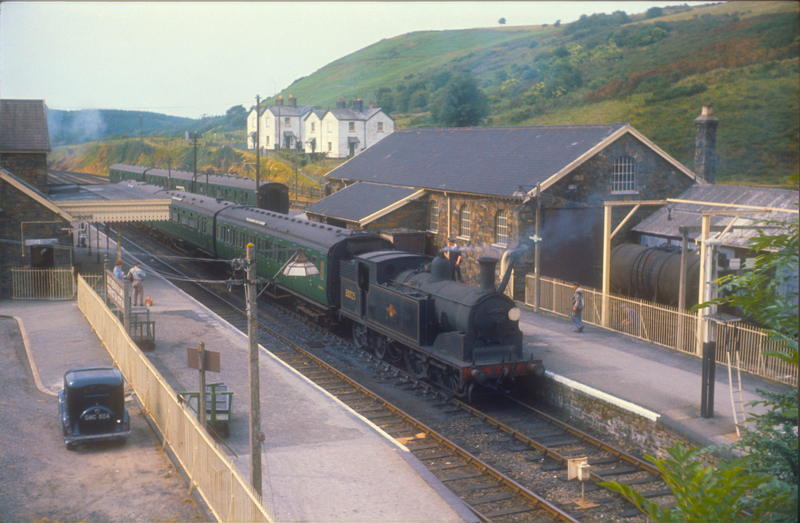
In 1962, while the Atlantic Coast Express would have left Waterloo behind a Bulleid Pacific, at journey’s end it would be something more modest, such as ex LSWR Drummond M7 0-4-4T, seen taking water after bringing in the Torrington portion. Image: the late Stuart Underdown.
Our tour continued down the Swanage branch with a Q1 on tour “The Wealdsman”. For fans of rail tours the whole evening was a gem and with much to remember for participants. Not forgetting the railmen who made it all possible. So, we saw a smiling locomotive Inspector Oliver by a loco at Christ’s Hospital
Finally, after a Vectis and Hayling island tour we finished off with engineering work at Stuart’s local stations Lewisham Road and Ladywell showing the kind of scenes impossible to photograph these days. A great shot of Thermit welding! Wow.
We concluded with some old B and W pictures including a 1915 station queue for spuds!
The ride was extensive and rapid but we were very pleased with what we saw the quality and variety were excellent. Thanks very much Jeremy. Is there a part two? We hope so. (CHJ 10/03/25)
4th February 2025: British Rail a New History - Christian Wolmar
Christian Wolmar was our notable branch speaker for February. Take one look at his web page and you will see his many achievements set out before you as well as a very busy timetable. The branch was therefore very lucky to have him before us and to enjoy his company. As the oft quoted media sage on railway matters, he lived up to his reputation. His numerous books were spread out before us for sale and those like me cash and card poor will be surely investing in the coming days. His latest book on the rise and fall of British railways was his topic but other books were available including a 2025 book on how the railways of France were rapidly reconstructed after the Normandy landings. This involved The USA in that the commanding 3rd Army General George Smith Patton who in a Trumpesk move had vast numbers of men navvying for months to ensure his petrol got to him by rail (Or was obtained from other units), this looks a fascinating book.
He returned to British Railways and Christian recounted its birth out of the wreckage of WW2 and was followed by nationalisation in 1948. At that time the railways enjoyed a post war boom and employed vast numbers compared to today 600,000 were quoted with 10,000 shed each following year and the BTC had its tentacles everywhere in a network of docks, canals, hotels, sea and land enterprises. The compensation payment to the previous companies was no doubt a welcome legacy to them. The numbers of employees were also swollen by 1000, s of horses and their needs. To add to the burden was the “common carrier” status which produced much unremunerative traffic (Yes, I remember two greyhounds tied to a lamppost overnight at Swansea High Street and a bag of decomposing cockles).
The photos shown were an eclectic mix as the topic developed. The modernisation plan was unveiled in 1955 but in some ways just offered a bit more of the same rather late with the wasteful construction of vast marshalling yards for unbraked wagons and new steam engines still being built. Closures continued on a piecemeal basis though during that period.
Then along came Dr Beeching with his much stronger brew amounting to virtual euthanasia in some minds and places but iconoclastic thinking to others. Out went steam and in came MGR trains and marketing. Musty rolling stock was disposed of. We should remember though that railways often benefit widely those people who don’t use them.
Into the 60’s with Marples and Castle brought further changes when Christian recounted that the railway was now to be split to a social side and a commercial side. There was much innovation and forward thinking with The APT and 125 concepts - the 125 won.
Under Thatcher came sectorisation and then the sell off all talked about in detail. He was clear that railways cannot flourish in Britain without some kind of government intervention and control and more of this is coming up with GBR. He did however finish off with praise for Peter Hendy and his role as the rail minister. If that leaves you wanting more then buy or borrow the book “British Rail a New History by Christian Wolmar. An excellent evening which terminated with questions and answers ably dealt with by our speaker.
7th January 2025: Bedford to Cambridge - Stephen Owen
This was the first meeting at Bedford of the New Year 2025, but it started on a sad note as Chairman Bill Davis asked members present to remember in silence our great friend Peter Neal who passed away rather suddenly in December (there is a tribute to him elsewhere).
Our speaker was Stephen Owen who is new to the branch as a speaker, but gave a very thorough history in words, pictures and text of the building and history of the Bedford to Cambridge Railway.
This is a line likely to reappear in a different location in the future as part of East/West Rail and Stephen covered that at the end of his talk in fact he reminded us that The Doctor (Beeching of course) did not include the line as part of his 1963 medicine and even proposed its development as an important cross-country link. However, “Battling Barbara Castle” had other ideas and it succumbed in 1968.
It is interesting that AI (Internet search) has it as a Beeching victim and our speaker amused us with an AI reference when he looked up George England, builder of Shannon, the engine on the Sandy to Potton Railway of 1857, he got information on young George Windsor by AI!
Stephen lives at North Rd Station and he has done an amazing amount to transform it back to its place in the railway landscape as it was soon after construction and opening in 1862. With even a reconstructed LNWR signal box as was, complete with frame.
After talk of canals, various routes were proposed for a railway which, rather like today’s East-West schemes, seem to wander around a map.
After opening the line was absorbed by the LNWR in 1865 who ran 7 trains a day and connected up with the Oxford line so the whole was known as “The Varsity Line” and might one day be again.
We saw various experiments with railbuses and railcars. In the 1950’s after nationalisation it ended up as part of three BR regions so no one seemed to care for it, So eventually a gradual run down came and closures of facilities then the sad end.
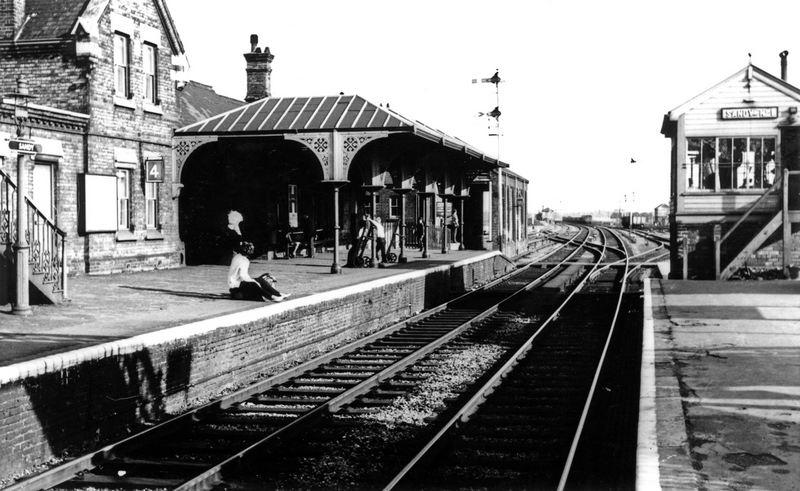 Sandy LNWR side, 1st June 1963
Sandy LNWR side, 1st June 1963
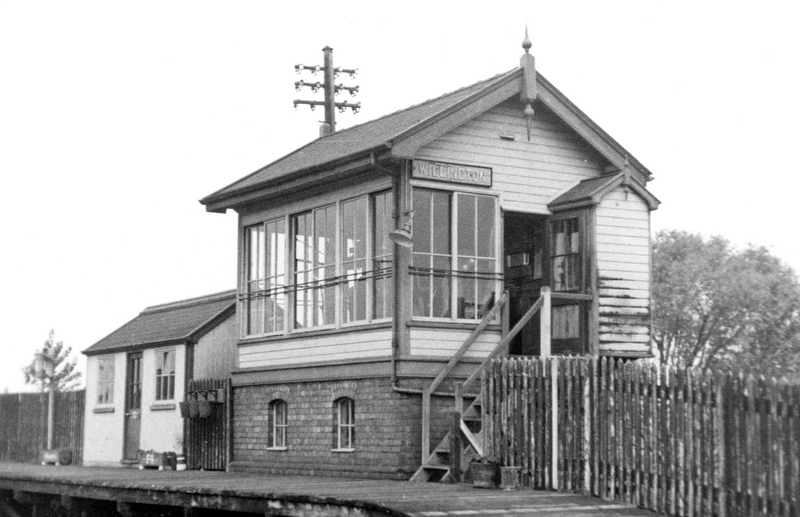 Willington Signal Box, circa 1965
Willington Signal Box, circa 1965
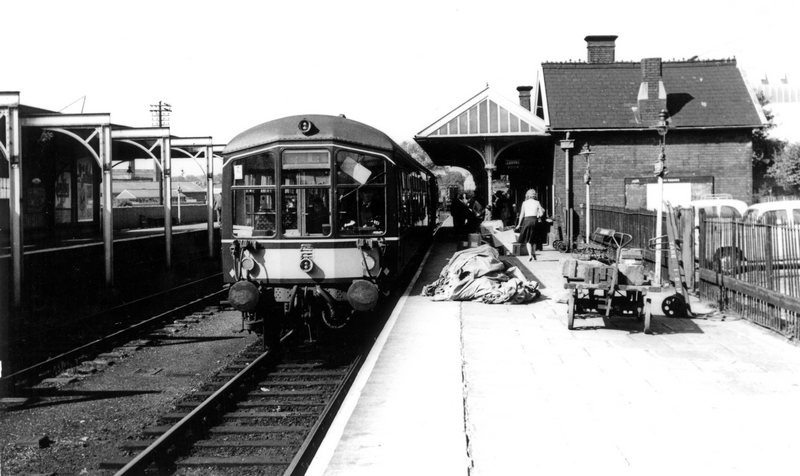 A Derby lightweight DMU at Bedford St John's in the morning of Saturday 31st July 1965
A Derby lightweight DMU at Bedford St John's in the morning of Saturday 31st July 1965
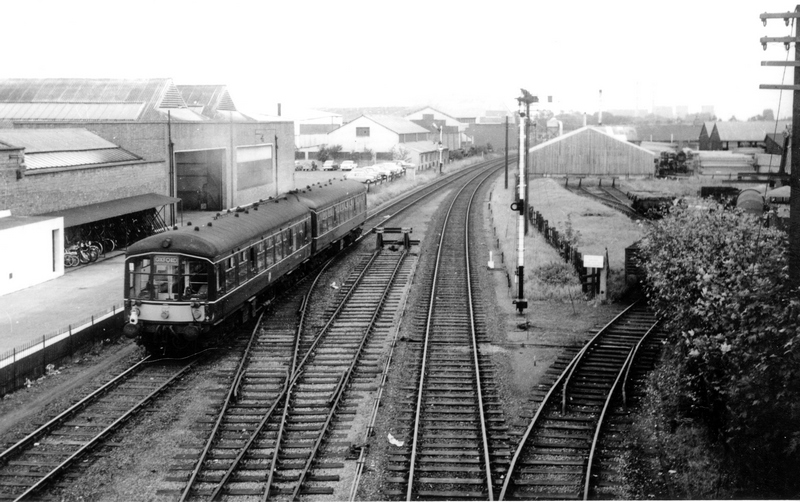 On the same day, a Derby lightweight DMU leaves Bedford St John's for Cambridge, looking east from London Rd Bridge, with Stirling's sidings on the right.
On the same day, a Derby lightweight DMU leaves Bedford St John's for Cambridge, looking east from London Rd Bridge, with Stirling's sidings on the right.
Our tour of the line was very thorough and covered stations, both in their heyday and as they remain today, often put to good use. Loops of all kinds showing that Stephen had done and continues to do a great deal of research into the remote loops and signal boxes often put in to cope with extra traffic in two world wars, showing the vital strategic nature of the line.
He showed off various artefacts - Webb and Thompson staffs, both standard and miniature, as well as numerous publications, both official and others. Maps and aerial photos gave additional coverage and the branch were also reminded that uniquely we had two people present who lived in stations on the line, as our old friend George Howe was also with us from Potton Station.
A superb evening for which we gave great thanks.
